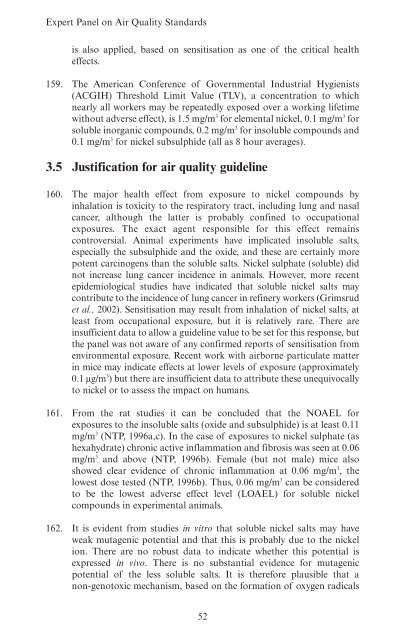Guidelines for Metals and Metalloids in Ambient ... - ARCHIVE: Defra
Guidelines for Metals and Metalloids in Ambient ... - ARCHIVE: Defra
Guidelines for Metals and Metalloids in Ambient ... - ARCHIVE: Defra
You also want an ePaper? Increase the reach of your titles
YUMPU automatically turns print PDFs into web optimized ePapers that Google loves.
Expert Panel on Air Quality St<strong>and</strong>ards<br />
is also applied, based on sensitisation as one of the critical health<br />
effects.<br />
159. The American Conference of Governmental Industrial Hygienists<br />
(ACGIH) Threshold Limit Value (TLV), a concentration to which<br />
nearly all workers may be repeatedly exposed over a work<strong>in</strong>g lifetime<br />
without adverse effect), is 1.5 mg/m 3 <strong>for</strong> elemental nickel, 0.1 mg/m 3 <strong>for</strong><br />
soluble <strong>in</strong>organic compounds, 0.2 mg/m 3 <strong>for</strong> <strong>in</strong>soluble compounds <strong>and</strong><br />
0.1 mg/m 3 <strong>for</strong> nickel subsulphide (all as 8 hour averages).<br />
3.5 Justification <strong>for</strong> air quality guidel<strong>in</strong>e<br />
160. The major health effect from exposure to nickel compounds by<br />
<strong>in</strong>halation is toxicity to the respiratory tract, <strong>in</strong>clud<strong>in</strong>g lung <strong>and</strong> nasal<br />
cancer, although the latter is probably conf<strong>in</strong>ed to occupational<br />
exposures. The exact agent responsible <strong>for</strong> this effect rema<strong>in</strong>s<br />
controversial. Animal experiments have implicated <strong>in</strong>soluble salts,<br />
especially the subsulphide <strong>and</strong> the oxide, <strong>and</strong> these are certa<strong>in</strong>ly more<br />
potent carc<strong>in</strong>ogens than the soluble salts. Nickel sulphate (soluble) did<br />
not <strong>in</strong>crease lung cancer <strong>in</strong>cidence <strong>in</strong> animals. However, more recent<br />
epidemiological studies have <strong>in</strong>dicated that soluble nickel salts may<br />
contribute to the <strong>in</strong>cidence of lung cancer <strong>in</strong> ref<strong>in</strong>ery workers (Grimsrud<br />
et al., 2002). Sensitisation may result from <strong>in</strong>halation of nickel salts, at<br />
least from occupational exposure, but it is relatively rare. There are<br />
<strong>in</strong>sufficient data to allow a guidel<strong>in</strong>e value to be set <strong>for</strong> this response, but<br />
the panel was not aware of any confirmed reports of sensitisation from<br />
environmental exposure. Recent work with airborne particulate matter<br />
<strong>in</strong> mice may <strong>in</strong>dicate effects at lower levels of exposure (approximately<br />
0.1 µg/m 3 ) but there are <strong>in</strong>sufficient data to attribute these unequivocally<br />
to nickel or to assess the impact on humans.<br />
161. From the rat studies it can be concluded that the NOAEL <strong>for</strong><br />
exposures to the <strong>in</strong>soluble salts (oxide <strong>and</strong> subsulphide) is at least 0.11<br />
mg/m 3 (NTP, 1996a,c). In the case of exposures to nickel sulphate (as<br />
hexahydrate) chronic active <strong>in</strong>flammation <strong>and</strong> fibrosis was seen at 0.06<br />
mg/m 3 <strong>and</strong> above (NTP, 1996b). Female (but not male) mice also<br />
showed clear evidence of chronic <strong>in</strong>flammation at 0.06 mg/m 3 , the<br />
lowest dose tested (NTP, 1996b). Thus, 0.06 mg/m 3 can be considered<br />
to be the lowest adverse effect level (LOAEL) <strong>for</strong> soluble nickel<br />
compounds <strong>in</strong> experimental animals.<br />
162. It is evident from studies <strong>in</strong> vitro that soluble nickel salts may have<br />
weak mutagenic potential <strong>and</strong> that this is probably due to the nickel<br />
ion. There are no robust data to <strong>in</strong>dicate whether this potential is<br />
expressed <strong>in</strong> vivo. There is no substantial evidence <strong>for</strong> mutagenic<br />
potential of the less soluble salts. It is there<strong>for</strong>e plausible that a<br />
non-genotoxic mechanism, based on the <strong>for</strong>mation of oxygen radicals<br />
52
















